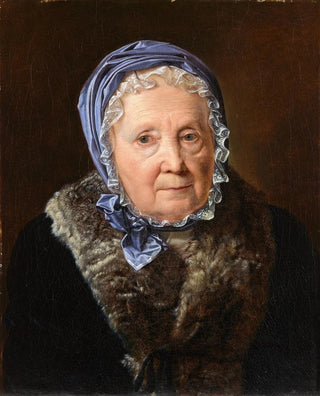Art print Rosina Wieser at age 83 - Ferdinand Georg Waldmüller


View from behind

Frame (optional)
Ferdinand Georg Waldmüller's art print "Rosina Wieser at the age of 83" is much more than a simple portrait. It embodies a meeting between the intimacy of the subject and the artistic mastery of its creator. Created in 1851, this piece reflects an era when the depiction of characters intertwined with profound psychological exploration. Through this artwork, viewers are invited to delve into the personal universe of Rosina Wieser, a woman whose wisdom and life experience shine through every brushstroke. Waldmüller, with his unparalleled talent, manages to capture not only the physical appearance of his model but also the very essence of her being, making this art print timeless.
Style and uniqueness of the work
Waldmüller's style is distinguished by a realistic approach and meticulous attention to detail. In "Rosina Wieser at the age of 83," the texture of the skin, the folds of clothing, and the sparkle in the eyes are rendered with a precision that borders on photographic realism. The color palette, soft and harmonious, enhances the serenity of Rosina's face, while the background, blurred and subtle, highlights the central figure. The artist uses light to shape the face of his model, creating a warm and welcoming atmosphere. Every element of the composition, from the choice of colors to the pose of the figure, contributes to a visual narrative that invites contemplation. Waldmüller succeeds in establishing a dialogue between the viewer and the subject, making the art print deeply emotional and engaging.
The artist and his influence
Ferdinand Georg Waldmüller is an emblematic figure of the 19th century, often regarded as one of the greatest representatives of Austrian realism. His work is marked by a desire to depict everyday life with unprecedented accuracy, while injecting a psychological dimension into his portraits. Waldmüller drew inspiration from the artistic currents of his time, developing a personal style that is uniquely his own. His influence extends beyond his era, impacting generations of artists.

Matte finish

View from behind

Frame (optional)
Ferdinand Georg Waldmüller's art print "Rosina Wieser at the age of 83" is much more than a simple portrait. It embodies a meeting between the intimacy of the subject and the artistic mastery of its creator. Created in 1851, this piece reflects an era when the depiction of characters intertwined with profound psychological exploration. Through this artwork, viewers are invited to delve into the personal universe of Rosina Wieser, a woman whose wisdom and life experience shine through every brushstroke. Waldmüller, with his unparalleled talent, manages to capture not only the physical appearance of his model but also the very essence of her being, making this art print timeless.
Style and uniqueness of the work
Waldmüller's style is distinguished by a realistic approach and meticulous attention to detail. In "Rosina Wieser at the age of 83," the texture of the skin, the folds of clothing, and the sparkle in the eyes are rendered with a precision that borders on photographic realism. The color palette, soft and harmonious, enhances the serenity of Rosina's face, while the background, blurred and subtle, highlights the central figure. The artist uses light to shape the face of his model, creating a warm and welcoming atmosphere. Every element of the composition, from the choice of colors to the pose of the figure, contributes to a visual narrative that invites contemplation. Waldmüller succeeds in establishing a dialogue between the viewer and the subject, making the art print deeply emotional and engaging.
The artist and his influence
Ferdinand Georg Waldmüller is an emblematic figure of the 19th century, often regarded as one of the greatest representatives of Austrian realism. His work is marked by a desire to depict everyday life with unprecedented accuracy, while injecting a psychological dimension into his portraits. Waldmüller drew inspiration from the artistic currents of his time, developing a personal style that is uniquely his own. His influence extends beyond his era, impacting generations of artists.
12,34 €






